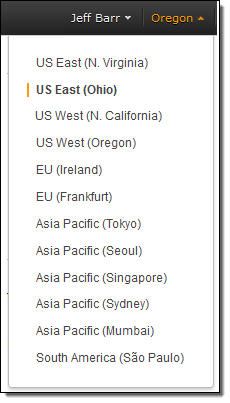AWS News Blog
Now Open – AWS US East (Ohio) Region
|
|
September 8, 2021: Amazon Elasticsearch Service has been renamed to Amazon OpenSearch Service. See details.
As part of our ongoing plan to expand the AWS footprint, I am happy to announce that our new US East (Ohio) Region is now available. In conjunction with the existing US East (N. Virginia) Region, AWS customers in the Eastern part of the United States have fast, low-latency access to the suite of AWS infrastructure services.
The Details
 The new Ohio Region supports Amazon Elastic Compute Cloud (Amazon EC2) and related services including Amazon Elastic Block Store (Amazon EBS), Amazon Virtual Private Cloud (Amazon VPC), Auto Scaling, Elastic Load Balancing, NAT Gateway, Spot Instances, and Dedicated Hosts.
The new Ohio Region supports Amazon Elastic Compute Cloud (Amazon EC2) and related services including Amazon Elastic Block Store (Amazon EBS), Amazon Virtual Private Cloud (Amazon VPC), Auto Scaling, Elastic Load Balancing, NAT Gateway, Spot Instances, and Dedicated Hosts.
It also supports (deep breath) Amazon API Gateway, Amazon Aurora, AWS Certificate Manager (ACM), AWS CloudFormation, Amazon CloudFront, AWS CloudHSM, Amazon CloudWatch (including CloudWatch Events and CloudWatch Logs), AWS CloudTrail, AWS CodeCommit, AWS CodeDeploy, AWS CodePipeline, AWS Config, AWS Database Migration Service (AWS DMS), AWS Direct Connect, Amazon DynamoDB, Amazon Elastic Container Registry (Amazon ECR), Amazon Elastic Container Service (Amazon ECS), Amazon Elastic File System (Amazon EFS), Amazon ElastiCache, AWS Elastic Beanstalk, Amazon EMR, Amazon Elasticsearch Service, Amazon Glacier, AWS Identity and Access Management (IAM), AWS Snowball, AWS Key Management Service (AWS KMS), Amazon Kinesis, AWS Lambda, AWS Marketplace, AWS Mobile Hub, AWS OpsWorks, Amazon Relational Database Service (Amazon RDS), Amazon Redshift, Amazon Route 53, Amazon Simple Storage Service (Amazon S3), AWS Service Catalog, Amazon Simple Notification Service (Amazon SNS), Amazon Simple Queue Service (Amazon SQS), AWS Storage Gateway, Amazon Simple Workflow Service (SWF), AWS Trusted Advisor, VM Import/Export, and AWS WAF.
The Region supports all sizes of C4, D2, I2, M4, R3, T2, and X1 instances. As is the case with all of our newer Regions, instances must be launched within a Virtual Private Cloud (read Virtual Private Clouds for Everyone to learn more).
Well Connected
Here are some round-trip network metrics that you may find interesting (all names are airport codes, as is apparently customary in the networking world; all times are +/- 2 ms):
- 10 ms to ORD (home to a pair of Direct Connect locations hosted by QTS and Equinix and an Internet exchange point).
- 12 ms to IAD (home of the US East (N. Virginia) Region).
- 18 ms to JFK (home to another exchange point).
- 52 ms to SFO (home of the US West (N. California) Region).
- 68 ms to PDX (home of the US West (Oregon) Region].
With just 12 ms of round-trip latency between US East (Ohio) and US East (N. Virginia), you can make good use of unique AWS features such as S3 Cross-Region Replication, Cross-Region Read Replicas for Amazon Aurora, Cross-Region Read Replicas for MySQL, and Cross-Region Read Replicas for PostgreSQL. Data transfer between the two Regions is priced at the Inter-AZ price ($0.01 per GB), making your cross-region use cases even more economical.
Also on the networking front, we have agreed to work together with Ohio State University to provide AWS Direct Connect access to OARnet. This 100-gigabit network connects colleges, schools, medical research hospitals, and state government across Ohio. This connection provides local teachers, students, and researchers with a dedicated, high-speed network connection to AWS.
14 Regions, 38 Availability Zones, and Counting
Today’s launch of this 3-AZ Region expands our global footprint to a grand total of 14 Regions and 38 Availability Zones. We are also getting ready to open up a second AWS Region in China, along with other new AWS Regions in Canada, France, and the UK.
Since there’s been some industry-wide confusion about the difference between Regions and Availability Zones of late, I think it is important to understand the differences between these two terms. Each Region is a physical location where we have one or more Availability Zones or AZs. Each Availability Zone, in turn, consists of one or more data centers, each with redundant power, networking, and connectivity, all housed in separate facilities. Having two or more AZ’s in each Region gives you the ability to run applications that are more highly available, fault tolerant, and durable than would be the case if you were limited to a single AZ.
Around the office, we sometimes play with analogies that can serve to explain the difference between the two terms. My favorites are “Hotels vs. hotel rooms” and “Apple trees vs. apples.” So, pick your analogy, but be sure that you know what it means!
— Jeff;
